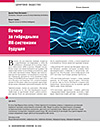Why the Future is with Hybrid AI Systems
Keywords:
,
,
,
,
The article by Gary Marcus Deep Learning: A Critical Appraisal [1] dwells on the questions about the current achievements of in-depth training and artificial intelligence (AI). The overall tone of the work is pessimistic and tends to rethink the results, even if they are intermediate. Markus makes forecasts and writes about the possible consequences of another hype around AI technologies [2]. The article gives a vision on which direction to move while developing AI systems.
References:
- Marcus G. Deep Learning: A Critical Appraisal. New York University, 2017. Cornell University Library, available at: https://arxiv.org/abs/1801.00631.
- Golovanov G. Gartner: “Khayp vokrug II idet vo vred tekhnologii i potrebitelyam” [Gartner: Hype Around AI is Harmful for Technology and Consumers]. Khaytek, 2017, July, 19, available at: https://hightech.fm/2017/07/19/ai-hype.
- Minsky M. Computation: Finite and Infinite Machines. Englewood Cliffs, N.J.: Prentice-Hall. 1967.
- Kolesnikov A.V. Gibridnye intellektual’nye sistemy: Teoriya i tekhnologiya razrabotki [Hybrid Intelligent Systems: Theory and Technology of Development]. Saint Petersburg, Izd-vo SPbGTU, 2001, 711 p.
- Medsker L.R. Hybrid Intelligent Systems. Boston: Kluwer Academic Publishers, 1995. 298 p.
- Eshbi U.R. Vvedenie v kibernetiku [Introduction to Cybernetics]. Moscow, Izd-vo inostrannoy literatury, 1959, 432 p.
- Weiss G. (ed.). Multiagent Systems. A Modern Approach to Distributed Artificial Intelligence. MIT Press, 1999.
- Wooldridge M. An Introduction to MultiAgent Systems. John Wiley & Sons Ltd, 2002, paperback, 366 p.
- Zaytsev I.M., Fedyaev O.I. Agentno-orientirovannyy podkhod k modelirovaniyu intellektual’nykh raspredelennykh system [Agent-Oriented Approach to Modelling Intelligent Distributed Systems]. Donetsk: DonNTU, 2008, pp. 337–338.
- José Antonio Martin H.; Javier de Lope; Darío Maravall. Adaptation, Anticipation and Rationality in Natural and Artificial Systems: Computational Paradigms Mimicking Nature. Natural Computing. Springer, 2009. 8 (4): pp. 757–775. doi:10.1007/s11047-008-9096-6.
- Bir S. Mozg firmy [Company Brain]. Moscow, Radio i svyaz’, 1993, 416 p.
- Gudfellou Ya., Bendzhio I., Kurvill’ A. Glubokoe obuchenie [Deep Learning]. Moscow, DMK Press, 2017, 652 p.
- Miller G.A., Chomsky N. Pattern conception. Paper for Conference on pattern detection, University of Michigan, 1957.
- Kallan R. Osnovnye kontseptsii neyronnykh setey [Basic Concepts of Neural Networks]. Moscow, Izdatel’skiy dom “Vil’yams”, 2001. 288 s.
- Kruglov V.V., Borisov V.V. Iskusstvennye neyronnye seti. Teoriya i praktika [Artificial Neural Networks. Theory and Practice]. Moscow, Goryachaya liniya — Telekom, 2001, 382 p.
- Nikolenko S., Kadurin A., Arkhangel’skaya E. Glubokoe obuchenie [In-depth Training]. Saint Petersburg, Piter, 2018, 480 p.
- Flakh P. Mashinnoe obuchenie [Machine Learning]. Moscow, DMK Press, 2015, 400 p.
- Huang S., Papernot N., Goodfellow I., Duan Y., Abbeel P. Adversarial Attacks on Neural Network Policies, 2017. arXiv, cs. LG.
- Kansky K., Silver T., Mély D. A., Eldawy M., Lázaro-Gredilla M., Lou X. et al. Schema Networks: Zero-shot Transfer with a Generative Causal Model of Intuitive Physics, 2017. arXIv, cs.AI.
- Kondakov N.I. Obobshchenie [Generalization]. Logicheskiy slovar’-spravochnik [Logical Dictionary-Directory]. 2-e izd. Moscow, Nauka, 1975, p. 395.
- Dushkin R.V. Metody polucheniya, predstavleniya i obrabotki znaniy s NE-faktorami [Methods for Obtaining, Presenting and Processing Knowledge with Non-Factors]. Moscow, 2011, 115 p.
- Marcus G. The Algebraic Mind: Integrating Connectionism and cognitive science. Cambridge, Mass.: MIT Press, 2001.
- Mikolov T., Chen K., Corrado G., Dean J. Efficient Estimation of Word Representations in Vector Space, arXiv, 2013.
- Socher R., Huval B., Manning C.D., Ng A.Y. Semantic compositionality through recursive matrix-vector spaces. Proceedings from Proceedings of the 2012 joint conference on empirical methods in natural language processing and computational natural language learning, 2012.
- Dobrov B.V., Ivanov V.V., Lukashevich N.V., Solov’ev V.D. Ontologii i tezaurusy: modeli, instrumenty, prilozheniya [Ontologies and Thesauri: Models, Tools, Applications]. Moscow, Binom. Laboratoriya znaniy, 2009, 173 p.
- Sowa J.F., Borgida A. Principles of Semantic Networks: Explorations in the Representation of Knowledge, 1991.
- Bart K. Neural Networks and Fuzzy Systems: A Dynamical Systems Approach to Machine Intelligence. Englewood Cliffs, NJ: Prentice Hall, 1992.
- Abraham A. Adaptation of Fuzzy Inference System Using Neural Learning, Fuzzy System Engineering: Theory and Practice, Nadia Nedjah et al. (Eds.), Studies in Fuzziness and Soft Computing, Springer Verlag Germany, Chapter 3, pp. 53–83, 2005.
- Dempster A.P. A generalization of Bayesian inference, Journal of the Royal Statistical Society, series B, vol. 30, pp. 205–247, 1968.
- Shafer G. A Mathematical Theory of Evidence, Princeton University Press, 1976.
- Zade L. Ponyatie lingvisticheskoy peremennoy i ego primenenie k prinyatiyu priblizhennykh resheniy [The Concept of a Linguistic Variable and Its Application to Adopting Approximate Solutions]. Moscow, Mir, 1976, 166 p.
- Dushkin R.V., Rybina G.V. Ob odnom podkhode k avtomatizirovannomu izvlecheniyu, predstavleniyu i obrabotke znaniy s NE-faktorami [One Approach to Automated Retrieval, Presentation and Processing of Knowledge with Non-Factors]. Izvestiya RAN. Teoriya i sistemy upravleniya [RAS Proceedings. Theory and Control Systems]. No 5. M., 1999, pp. 34–44.
- Khaykin S. Neyronnye seti: Polnyy kurs [Neural Networks: Full Course]. 2-e izd. Moscow, Izdatel’skiy dom “Vil’yams”, 2006, 1104 p.
- Knight W. DARPA is funding projects that will try to open up AI’s black boxes. MIT Technology Review. Retrieved 2017–11–02.
- Regina B., McCullough D., Rambow O., DeCristofaro J., Korelsky T., Lavoie B. A New Approach to Expert System Explanations. USAF Rome Laboratory Report.
- Haselton M. Error Management Theory. Journal of Personality and Social Psychology, 2000, January.
- Kerroll R.T. Entsiklopediya zabluzhdeniy: sobranie neveroyatnykh faktov, udivitel’nykh otkrytiy i opasnykh poveriy [Encyclopedia of Misconceptions: Collection of Incredible Facts, Amazing Discoveries and Dangerous Beliefs]. Moscow, Izdatel’skiy dom “Vil’yams”, 2005, 672 p.
- Loran P.Zh. Approksimatsiya i optimizatsiya [Approximation and Optimization]. Moscow, Mir, 1975, p. 496.
- Dushkin R.V., Zharkov A.D., Ivanov D.A. Ot bezopasnogo k umnomu gorodu — Nizhniy Novgorod: IT-forum – 2020. “Razvitie tsifrovogo gosudarstva. Sozdanie system vesogabaritnogo kontrolya, intellektual’nykh transportnykh system” [From Safe to Smart City — Nizhny Novgorod: IT forum – 2020. “Digital State Development. Creating Systems of Weight-Dimensional Control, Intelligent Transport Systems”]. Nizhniy Novgorod, 2017, April, 12–14.
- Terelyanskiy P.V. Sistemy podderzhki prinyatiya resheniy. Opyt proektirovaniya [Decision Support Systems. Design Experience]. Volgograd, VolgGTU, 2009, 127 p.



